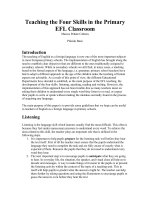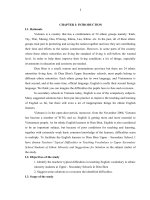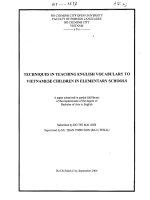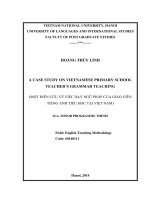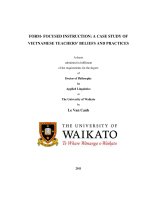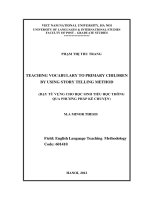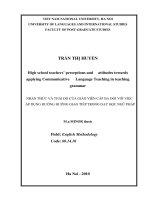TEACHING VOCABULARY TO YOUNG LEARNERS: VIETNAMESE PRIMARY EFL TEACHERS’ PERCEPTIONS AND PRACTICE
Bạn đang xem bản rút gọn của tài liệu. Xem và tải ngay bản đầy đủ của tài liệu tại đây (1.93 MB, 154 trang )
ACKNOWLEDGEMENTS
I would like to express my profound gratitude for all the blessings that I have
received as a doctoral student at Hue University of Foreign Languages.
I wish to send my deep thank to Associate Professor, Dr. Tran Van Phuoc,
Associate Professor, Dr. Truong Vien, Associate Professor, Dr. Le Pham Hoai
Huong, Dr. Truong Bach Le, Dr. Pham Hoa Hiep, Dr. Phan Quynh Như, Dr. Nguyen
Ho Hoang Thuy from University of Foreign Languages, Hue University, Associate
Professor, Dr. Ton Nu My Nhat from Quynhon University, Associate Professor, Dr. Le
Van Canh from Hanoi National University, Associate Professor, Dr. Nguyen Ngoc Vu
from Hoa Sen University and Associate Professor, Dr. Le Van Long from Danang
University for all the valuable feedback and advice during my doctoral study.
My heartfelt appreciation goes to my two supervisors, Associate Professor,
Dr. Pham Thi Hong Nhung and Dr. Ton Nu Nhu Huong for their professionalism,
patience, reference materials, continuous support and guidance throughout the years
of academic work. Their thorough and immediate feedback, profound insights,
professional support, dedication and devotion have given me admiration, respect
and affection. Without their invaluable support, this thesis is far from completion.
My special thanks go to my late parents for their advice, love and care that
have guided me to further my learning and fulfil my dual responsibility throughout
my walks of life.
My thanks go to my sister, Doan Thuy Hong for the updated books I need for
my exploration and to primary teachers and many others who have helped me in
different ways.
I am thankful to my husband, Doan Van Hung, and my two children for their
support, love and care during the journey.
i
ABSTRACT
Nowadays, early English education has become one of the increasing demands in
ASEAN nations. In Vietnam, English has been decided to be become a compulsory
subject to third graders upwards and optional downwards at schools since 2020 while
formal primary English language teacher education has remained scarce at universities
and colleges. As teaching vocabulary to language learners, especially to young language
learners, has been proved to be critical to their language acquisition, the overall aim of
this research is; therefore, to investigate Vietnamese EFL teachers‘ perceptions and their
practice of teaching vocabulary in elementary school settings in four provinces in Central
Vietnam. To answer the research questions, the investigation employed a quantitative and
qualitative approach through a questionnaire among 206 primary teachers in Central
Vietnam, 20 videotaped observations of 20 full class visits and in-depth interviews with
the teachers to explore their perceptions and assess their teaching practice. After
comparison and contrast of the observation and the questionnaire data were made, a few
existing peculiarities were further examined to verify teacher interview data. The
triangulated data results are surprisingly revealing in many essential aspects of
vocabulary instruction, ranging from selecting vocabulary, teaching vocabulary directly
and indirectly, explaining vocabulary meanings, teaching vocabulary through skills in
various teaching phases in class. Hopefully, the findings of the study have provided an
insightful understanding of vocabulary teaching practices in the primary school settings
in Vietnam. From these empirical findings, relevant implications are suggested for better
vocabulary instruction to young learners in Vietnam.
ii
TABLE OF CONTENTS
ACKNOWLEDGEMENTS .................................................................................................................................... I
ABSTRACT .............................................................................................................................................................II
TABLE OF CONTENTS ..................................................................................................................................... III
LIST OF FIGURES .............................................................................................................................................. VI
LIST OF TABLES ................................................................................................................................................ VI
LIST OF ABBREVIATIONS .............................................................................................................................VII
CHAPTER 1 ............................................................................................................................................................. 1
INTRODUCTION.................................................................................................................................................... 1
1.1.
BACKGROUND OF PRIMARY ENGLISH EDUCATION IN ASIA AND IN VIETNAM...................1
1.2.
RESEARCH RATIONALE .......................................................................................................5
1.3.
RESEARCH QUESTIONS........................................................................................................6
1.4.
RESEARCH SCOPE................................................................................................................6
1.5.
RESEARCH SIGNIFICANCE ...................................................................................................7
1.6.
STRUCTURE OF THE THESIS .................................................................................................7
CHAPTER 2 ............................................................................................................................................................. 9
LITERATURE REVIEW ....................................................................................................................................... 9
2.1. DEFINITIONS OF THE KEY TERMS .............................................................................................9
2.1.1. Young learners ..............................................................................................................9
2.1.2. Vocabulary ....................................................................................................................9
2.1.3. Perceptions of teaching vocabulary to YLLs .............................................................11
2.1.4. Practice of teaching vocabulary to YLLs ...................................................................11
2.2. YOUNG LANGUAGE LEARNERS‘ CHARACTERISTICS ..............................................................12
2.3. CHILD LANGUAGE ACQUISITION AND LEARNING...................................................................14
2.3.1.
Vygotsky’s guidelines in child language development .......................................14
2.3.2. Child first language acquisition and learning ...........................................................16
2.3.3. Child foreign language learning ................................................................................17
2.4. FOREIGN LANGUAGE TEACHING APPROACHES, METHODS AND TECHNIQUES FOR YLLS......20
2.5. CHILD FOREIGN LANGUAGE VOCABULARY LEARNING AND TEACHING.................................21
2.5.1. The importance of vocabulary in early foreign language learning ..........................21
2.5.2. Factors influencing young learners’ vocabulary learning.......................................22
2.6. TEACHING VOCABULARY .......................................................................................................23
2.6.1. Selecting vocabulary for instruction ..........................................................................23
iii
2.6.2. Direct and indirect teaching .......................................................................................26
2.6.3. Explaining vocabulary meanings ...............................................................................29
2.6.4. Developing vocabulary through skills for communication .......................................31
2.6.5. Conducting vocabulary teaching procedures ............................................................34
2.7. PREVIOUS STUDIES ON TEACHING VOCABULARY TO YOUNG LANGUAGE LEARNERS............36
2.8. CHAPTER SUMMARY ..............................................................................................................43
CHAPTER 3 ...........................................................................................................................................................44
RESEARCH METHODOLOGY.........................................................................................................................44
3.1. RESEARCH DESIGN .................................................................................................................44
3.2. RESEARCH PARTICIPANTS ......................................................................................................47
3.3. THE ROLE OF THE RESEARCHER .............................................................................................51
3.4. RESEARCH PROCEDURE AND ADMINISTRATION.....................................................................52
3.5. RESEARCH INSTRUMENTS ......................................................................................................53
3.5.1. Questionnaire ..............................................................................................................55
3.5.2. Classroom observation ...............................................................................................57
3.5.3. Interview ......................................................................................................................60
3.6. DATA ANALYSES ....................................................................................................................62
3.7. ETHICAL CONSIDERATIONS ....................................................................................................66
3.8. RESEARCH RELIABILITY AND VALIDITY.................................................................................66
3.8.1. Research reliability .....................................................................................................66
3.8.2. Research validity .........................................................................................................68
3.9. CHAPTER SUMMARY ..............................................................................................................69
CHAPTER 4 ...........................................................................................................................................................70
FINDINGS AND DISCUSSIONS ........................................................................................................................70
4.1. TEACHERS‘ PERCEPTIONS OF TEACHING VOCABULARY TO YLLS ........................................70
4.1.1. Teachers’ perceptions of choices of vocabulary to be taught ...................................70
4.1.2. Teachers’ perceptions of direct and indirect teaching ............................................73
4.1.3. Teachers’ perceptions of explaining word meanings ................................................76
4.1.4. Teachers’ perceptions of developing vocabulary through skills for communication .79
4.1.5. Teachers’ perceptions of vocabulary teaching procedures ......................................82
4.2. TEACHERS‘ PRACTICE OF TEACHING VOCABULARY TO YLLS ..............................................85
4.2.1. Teachers’ practices of selecting vocabulary to teach................................................86
4.2.2. Teachers’ use of vocabulary teaching techniques .....................................................89
iv
4.2.3. Teachers’ practices of explaining vocabulary meanings ..........................................93
4.2.4. Teachers’ practices of developing vocabulary through skills for communication100
4.2.5. Teachers’ practices of vocabulary teaching procedures ....................................... 107
4.3. CHAPTER SUMMARY ........................................................................................................... 110
CHAPTER 5 .........................................................................................................................................................114
CONCLUSION.....................................................................................................................................................114
5.1. SUMMARY OF THE KEY FINDINGS........................................................................................ 114
5.1.1. Teachers’ perceptions of teaching vocabulary to YLLs ......................................... 114
5.1.2. Teachers’ practice of teaching vocabulary to YLLs ............................................... 116
5.2. IMPLICATIONS ..................................................................................................................... 121
5.2.1. To primary teachers ................................................................................................. 121
5.2.2. To teacher trainers at universities and colleges ..................................................... 124
5.2.3. To the designers of the currently used textbooks in Vietnam ................................. 125
5.2.4. To school authorities and educational administrators ........................................... 126
5.3. LIMITATIONS OF THE STUDY ............................................................................................... 126
5.4. SUGGESTIONS FOR FURTHER STUDY ................................................................................... 127
PUBLISHED ARTICLES ...................................................................................................................................128
REFERENCES .....................................................................................................................................................129
APPENDIX 1 ........................................................................................................................................................139
THE QUESTIONNAIRE ....................................................................................................................................140
OBSERVATION CHECKLIST (TEACHER ID 1-20) ...................................................................................143
SEMI- INTERVIEW QUESTIONS: .................................................................................................................146
APPENDIX 2: RAW DATA ...............................................................................................................................147
v
LIST OF FIGURES
Figure 2.1
Child foreign language learning
p. 18
Figure 2.2
Gradual release of responsibility for vocabulary
p. 35
LIST OF TABLES
Table 2.1
Practices of multidimensional vocabulary instruction
p. 27
Table 3.1
Research design
p. 47
Table 3.2
A brief description of the survey participants
p. 49
Table 3.3
Timeline for collecting data
p. 53
Table 3.4
Timeline for processing data
p. 53
Table 3.5
A summary of data collection methods
p. 54
Table 3.6
The coding scheme of the questionnaire
p. 63
Table 3.7
The coding scheme of the observation transcripts
p. 65
Table 3.8
Cronbach‘s alpha coefficients of the components in the p. 67
questionnaire
Table 4.1
Teachers‘ perceptions of choices of vocabulary to be p. 71
instructed
Table 4.2
Teachers‘ perceptions of techniques used to teach p. 74
vocabulary
Table 4.3
Teachers‘ perceptions of explaining word meanings
Table 4.4
Teachers‘ perceptions of teaching YLLs vocabulary to p. 80
p. 77
develop skills for communication
Table 4.5
Teachers‘ perceptions of vocabulary teaching procedures
vi
p. 83
LIST OF ABBREVIATIONS
ASEAN
Association of South East Asian Nations
CEFR
The Common European Framework of Reference for Languages
CLT
Communicative Language Teaching
EFL
English as a Foreign Language
L1
Native Language or Mother Tongue
L2
Second Language
FL
Foreign Language
MOET
Ministry of Education and Training of Vietnam
PELT
Primary English Learning and Teaching
PPP
Presentation – Practice – Production
SD
Standard Deviation
TEYL
Teaching English to Young Learners
TPR
Total Physical Response
YLLs
Young Language Learners
vii
CHAPTER 1
INTRODUCTION
This chapter introduces the current situation of teaching and learning
English at primary school level in Asia and Vietnam. Research rationale, questions
and research objetives of the current study are presented. The organization of the
thesis is described.
1.1.
Background of primary English education in Asia and in Vietnam
A brief review of the background of English learning and teaching in Asia and
in Vietnam highlights an urgent need to investigate into primary English learning and
teaching (PELT). In Asia, the fact that the scope of English learners has been expanded
to elementary pupils has brought both opportunities and challenges for not only
learners, teachers but teacher trainers, researchers, educational administrators and
policy makers as well.
The short-and-long-term benefits of early English learning are that pupils
learning English can not only get to know about the target language, learn more
about their counterparts‘ daily life from modern English speaking countries for
intercultural enrichment but also may developmentally improve their personal
growth or get access to further educational opportunities for a bright future with
parental expectations and teacher support. This direction in PELT receives warm
welcome from young learners, parents, teachers, researchers and foreign language
planners and policy makers in many countries such as in China, Japan and
Singapore (Silver, et al., 2001) or in other Asian countries like Hong Kong,
Philippines, Korea, Thailand, Japan, India, Vietnam, Iran, and other English
speaking countries namely Finland, Israel, Russia, Norway, France, Switzerland
(Spolsky & Moon, 2012). Besides, the local and global concerns that attracted much
attention from many researchers in the early 2000s were ―At what age should young
language learners (YLLs) start learning a foreign language for optimal results?‖,
1
―What are the influential factors in early foreign language learning?‖ or ―Why are
foreign languages important to young learners?‖ (Nikolov, 2002; Moon, 2005).
These interests have gradually shifted into many theoretical and practical areas such
as ―How should YLLs be instructed?‖ or ―How should YLLs be assessed?‖
(Halliwell, 1992; Nikolov, 2009; McKay, 2008; Wray & Medwell, 2008; Garton, et
al., 2011). Simultaneously, in those studies, many significant gaps in formal training
in teaching methodology as well as teaching practice at young ages have been
illuminated because primary teacher preparation or provision, textbook designing,
testing, assessment, evaluation, language policy development and planning are not
in pace with the public learning demands.
As part of the above Asian mosaic, Vietnam is not an exception. From the
historical perspectives, PELT has undergone through some historic milestones (Do
Huy Thinh, 1996; Le Van Canh, 2008). First, when Vietnam‘s membership in
ASEAN in 1995, the young age range for piloting English programs started with
third graders upwards at experimental primary schools in big cities the mid-1900s
and flourished nationwide considerably, initially from public institutes to private
sectors, urban localities and even to rural areas. Along with the significant increase
in the population, the next revolutionary turning point was the modification of the
language policy at primary levels articulated in the official declaration of National
Foreign Language Project 2020, at Decision 1400/QD-TTg, 2008. The ultimate goal
of primary foreign language education is to equip every Vietnamese primary pupil
with basic English communicative competence at A1 level in the Common
European Reference Framework so that they can become global citizens in world
integration (MOET, 2014).
Throughout such above historic milestones, a lot of Vietnamese and foreign
teachers and applied linguists have drawn attention to young English education
through their empirical studies in Vietnamese primary school settings. For example,
at a macro planning level, Nguyen Thi Mai Hoa and Nguyen Quoc Tuan (2008)
featured the overview picture of Vietnamese early English learning in the model of
2
Language-in-Education policy and planning for merits and demerits. From another
exploratory case study of the policy implementation two types of primary schools,
private and public, Nguyen Thi Mai Hoa (2011) highlighted a number of the
language planning issues of teacher supply, methods, materials, training, and
professional development in order to boost the effectiveness of the English language
policy implementation while from top-down and bottom-up angles, Pham Thi Hong
Nhung (2013, 2015), in her reports about a large-scale investigation into primary
teachers in Hue province, penetrated into both positive impacts of the government
primary language policy on teacher training and professional improvement and the
obstacles or factors that hinder primary English teachers from their effective
practice for quality enhancement. With the similar aspects but in different research
sites, Nguyen Thi Thuy Trang (2012) interpreted early English education in rural
areas on the framework of Language in Education policy.
Beside the insiders‘ perspectives, several international researchers were also
interested in PELT in Vietnam. For example, Hayes (2008) carried out an empirical
study on early English education in the context of Vietnam regarding learning time
per week, the capacity of MOET and curriculum and textbook developers to
produce a curriculum, books and assessment framework which will make a
meaningful difference to children‘s educational experiences, the current textbook
quality, the capacity of teachers and schools as a whole to implement the proposed
changes, the training capacity to introduce the changes, the impact of changes to the
primary English curriculum on the secondary English curriculum, the impact of
changes in the primary English curriculum. Similarly, Baldauf, et al. (2011), by
briefing the results of the language planning to find the impacts of English on
community policy and evaluation policy for success or failure in nine Asian regions
among which was the school contexts in Vietnam, pointed out the mismatches
between the evaluation focus - pupils‘ communicative competence in language use
at A1 level in CEFR and teaching practice due to lack of qualified teachers and
resources. More specifically, Moon (2009) in her exploratory study focused on
3
primary English teachers and the varied influences which shape their thinking and
practice, highlighting that one of the key elements that needs addressing for success
in the low resourced contexts of Vietnam is the primary teacher of English.
Primary English teachers play a critical role along with materials in implementing
TEYL in Vietnam and in influencing outcomes. … In general, they are not equipped
to fulfill their role effectively and to enable MOET to achieve its new curriculum
aims. Due to the current policy, their status is low, affecting their motivation and
commitment to a career in TEYL. They are not trained to teach children and many,
despite their English degrees, have low proficiency, so they are not able to capitalize
on the key advantage they have as language specialists (p.328).
All the three studies acknowledged the significant role of the primary
teacher, however, they offered little clarification in categories of such insufficiency
in primary English teacher education. Apparently, primary teacher preparation and
training in Vietnam has come under the spotlight. According to 2013-2014 MOET
report, the national primary teachers were reported to be of mixed levels of language
proficiency. Most primary teachers have not been trained to teach young schoolaged learners because primary English language teacher education has not been
popular at universities in Vietnam except Hue University, Danang University and
Hanoi University. Such gaps in primary EFL teacher at primary level were validated
in teaching knowledge, skills and language proficiency (Le Van Canh & Do Mai
Chi, 2012). To deal with the insufficiency in PELT knowledge and practical skills,
MOET conducted an initial outreaching program in conjunction with British
Council to provide about 150 university teachers and primary teachers with a oneyear intensive program to become key primary teacher trainers in 2013. Since then,
teacher training has been taken into consideration.
Whether the views are from inside or outside, what both sides highlight is the
increasing social demand and the emphasis on young English learners as well as the
elaborate preparation of teaching staff especially in terms of sufficient official
training, language proficiency and language teaching methods. Apparently, one of
4
the major issues in the above research concerned for successful innovations in
primary English is language teacher education.
1.2.
Research rationale
The above global and regional impacts - the development of science, high
technology, education and the global popularity of English expanding their influence
on primary English learning and teaching - have urged Vietnam to promote
innovations in language planning and policy for world integration. Therefore, a
Circular 7274/BGDĐT-GDĐH dated 31/10/2012 on the National Foreign Languages
Project 2020 has been issued from MOET in conjunction with the British Council for
the recent long-and-short-term foreign language policies in teaching and language
proficiency assessment for English teachers of all levels including primary levels like
many other Asian countries (Nguyen Thi Mai Hoa & Nguyen Quoc Tuan, 2008;
Nguyen Thi Mai Hoa, 2011; Pham Thi Hong Nhung, 2015).
More significantly, the social demands of learning primary English as a FL in
Vietnam are increasing so dramatically that primary EFL teacher preparation is not
in pace with such the learning movements (Pham Thi Hong Nhung, 2013, Le Van
Canh and Do Mai Chi, 2013; Mai Vu Trang & Pham Thi Thanh Thuy, 2014; Le
Van Canh & Nguyen Thi Ngoc, 2017). The demands of learning English as a FL
especially at primary levels are increasing so dramatically that primary FL teachers
are being understaffed and unofficially trained. Researching primary foreign
language learning, Cameron (2001), Beck et al. (2002), Beck & McKeown (2007),
Hedge (2008) emphasized that it is essential to take vocabulary instruction into great
consideration because of its utmost importance during this stage. There has been a
negligence in primary language teacher education, which may result in elementary
teachers‘ incomplete knowledge and ineffective teaching practices in this area.
Individually, this study originated from the researcher‘s dual role as a
university instructor in teacher training and engagement as a primary teacher trainer
in the National Foreign Language Project 2020. The more involved the researcher
5
was in the British Council training in primary English teacher education of Project
2020, the more aware the researcher became of the differences in how adults and
children learn English and of the gaps between the current university curricula and
in primary English teacher education especially in the area of building up
vocabulary for YLLs. Although extensive research has been carried out on teaching
vocabulary, very few existing studies focus on teaching vocabulary to primary
learners and even fewer investigations have been carried out in EFL teachers‘
perceptions and their practice for enhancement.
It is these social, institutional and individual reasons that have urged the
present study to be delved into on Vietnamese primary EFL teachers‘ perceptions
and practice in teaching vocabulary to YLLs.
1.3.
Research questions
The present study seeks to answer the following questions:
1. What are Vietnamese primary EFL teachers‘ perceptions of teaching
vocabulary to young language learners?
2. How do Vietnamese primary EFL teachers teach vocabulary to young
language learners in class?
1.4.
Research scope
From the above research questions, the study scope was narrowed down
among 206 primary EFL teachers in four provinces in Central Vietnam (Binhdinh,
Danang, Gialai, Kontum), where Quynhon University has been tasked to deliver
many teacher training workshops by the National Foreign Languages Project. More
specifically, the research investigated both the Vietnamese EFL teachers‘
perceptions and practices of teaching vocabulary to primary school students.
Comparison between their perceptions and practices were also made.
6
1.5.
Research significance
The study has significant values.
First, this research aims to provide
insightful understandings of Vietnamese EFL teachers‘ perceptions and their actual
practice of teaching vocabulary to YLLs in primary classes, exploring underlying
factors influential to this process. This study draws from the perceptions and reallife experiences of primary EFL teachers who have not been trained to teach young
learners. Therefore, it both documents their views on how different aspects of
vocabulary should be taught to young learners and describes in detail what they
really do in their vocabulary instruction in their classroom. Secondly, the
importance of this study is that the evidence-based findings can help identify hidden
factors that have influenced Vietnamese primary EFL teachers‘ perceptions of the
nature of vocabulary that then may be influential to their teaching practice in the
context of Vietnamese school settings. Thirdly, the findings in different aspects of
teaching vocabulary to young learners hopefully provide the basis for relevant
vocabulary-oriented instruction modifications for primary English education,
teacher training curricula, teacher support and textbook designs as well.
1.6.
Structure of the thesis
The thesis is structured in five chapters.
Chapter One introduces the background of primary English education in the
world and in Vietnam, the purpose of the research, the significance of the study to
focus on
the Vietnamese teachers‘ perceptions and practices in teaching EFL
vocabulary to primary learners.
Chapter Two deals with the literature review which is built on our critical
analysis and synthesis of the previous relevant studies in vocabulary instruction to
third graders upwards in elementary foreign language education. The review is
aimed to establish the space for the research questions of the study.
7
Chapter Three focuses on the methodology of the research. It presents and
justifies the three research approaches adopted, the participants and data collection
instruments employed. How the collected data are processed and analyzed is also
described.
Chapter Four presents the data and discusses the findings to answer the two
research questions. The quantitative analysis of the questionnaire data addresses the
first question on the participants‘ perceptions. The quantitative analyses of the
observation checklist and the qualitative analyses of the descriptive transcripts
yields the evidence of the second question in triangulation of, the observation data
and the interview data the questionnaire data for the influential factors.
Chapter Five presents major findings and relevant implications as well as
suggestions for future research.
8
CHAPTER 2
LITERATURE REVIEW
This chapter critically reviews the literature relevant to the study. It provides
definitions of concepts central to the present research, addresses the core literature
on child vocabulary acquisition and teaching vocabulary to young language learners.
Relevant previous studies are reviewed. From our analysis and synthesis of the
literature, a space is established for the research questions of the current study.
2.1. Definitions of the key terms
Within this section, the definitions of key terms fundamental to the study are
provided.
2.1.1. Young learners
The phrase ―young (language) learners‖ is used to refer to children of
different age groups, varying from toddlers to primary school students. However, in
the literature on teaching foreign languages to children (e.g. Cameroon, 2001;
Nunan, 2011), young learners are often defined as children at primary school age,
typically of 6 to 11 or 12 years of age.
The present study focuses on primary school students in Vietnam, who
commonly start to learn English as a foreign language (EFL) from grade 3 through
grade 5. Therefore, the term, “young (language) learners” in this paper refers to
Vietnamese EFL children of 8-11 years of age.
2.1.2. Vocabulary
Vocabulary is a commonly-used term and yet it is difficult to define precisely
because there have been so many theories in different disciplines and this term has
two overlapping, even slightly confusing meanings between vocabulary and words.
For example, Nation (1990), McCarthy (1990) and Schmitt (2000), who made
9
significant contributions to vocabulary studies, explained vocabulary through
different types of word knowledge (meaning, forms and use) in receptive and
productive skills without giving clear-cut definitions. In the lexical approach, Lewis
(2008, p. 7) expanded vocabulary boundary into single words, polywords,
collocations, fixed expressions or chunks as building blocks of all natural language.
The above explanations are very helpful with the the essential elements of
vocabulary, chunks as natural language blocks but their discussions about
vocabulary taught to young learners were not included.
Likewise, according to Linse (2005), ―language consists of words and
vocabulary is the collection of words that a child knows or learns‖ (p. 121). More
specifically, in Applied linguistics and primary school teaching, Ellis and
McCartney (2011) agreed on such views on Vocabulary with the above properties of
vocabulary, but provided with more clarification on YLL‘s comprehension and
communication values in their oracy and literacy:
Words have power. Spoken words convey meaning and intent. Without an
understanding and facility with spoken words, face-to-face communication can
be impeded. Written words are equally powerful. Successful reading and
writing require strong knowledge of the written word. Children must know how
to read words to access meaning at the word, sentence and text level. Equally
important, children also must be able to spell words correctly to convey
accurate and appropriate information to their readers. (p.229)
Even Cameron (2001, p. 50) pointed out the beneficial role of word chunks
as ―stepping stones‖ for young learners to move to grammar effortlessly in their
language development. From the reviewed literature, throughout the current study,
vocabulary, synonymous to words, is defined as the collection of meaningful
chunks including single words or multi-unit words – collocations, set expressions
and idioms.
10
2.1.3. Perceptions of teaching vocabulary to YLLs
Perception, another key term in the research, is defined as recognition or
understanding which is reflected through the use of senses and intentions and
categorized into visual perception, auditory perception and speech perception (Maund,
2003). Richards & Schmidt (2012) pointed out that teachers‘ perceptions may differ
from teachers‘ belief in a way that the latter is thought to be ―stable constructs derived
from their experience, observations, training and other sources and may be difficult to
change‖ (p. 586). The distinction could be used to clarify incomplete training that may
result in vague perceptions. In fact, both perceptions and beliefs belong to the umbrella
term cognition. Teacher cognition could be influenced by ―schooling, professional
coursework, contextual factors and classroom practice‖ (Borg, 2006, p. 41).
In
language teacher cognition research, teachers are seen as key players or decision
makers to shape classroom events; that is, their understanding guides them to think,
make choices or decisions of what, why and how to carry out classroom practice
(Cameron, 2001; Barnard & Burns, 2012).
In this research, to primary teachers who were instructed how to teach
vocabulary in general may develop their beliefs about vocabulary instruction but
may have perceptions of teaching vocabulary to YLLs due to their insufficient
training to the young learner type. So the term perception will be used to describe
this phenomenon and refer to their intention, recognition and understanding of their
teaching behaviours in teaching vocabulary to learners of this age group.
2.1.4. Practice of teaching vocabulary to YLLs
Richards & Schmidt (2012) assumed that ―beliefs also serve as the source of
teachers‘ classroom practices‖ (p. 586) and so do perceptions to some extent. What
teachers perceive, think and believe can be reflected through what they do, say and
conduct in their class and may be visually and auditorily observable (Borg, 2006;
Barnard & Burns, 2012). In the light of applied linguistics and cognitive
psychology, DeKeyser (2007) defined the term teacher practice as ―specific
activities or teaching techniques in the foreign or second language engaged in
11
systematically, deliberately, with the goal of developing knowledge of and skills in
the foreign or second language‖ (p. 8). Apparently, what teachers do, say and
conduct in their class which often originates from their beliefs or perceptions has
been referred to practice or practices. In this sense, the two terms ‗practice‘ and
‗practices‘ of teaching vocabulary to YLLs are used interchangeably. Additionally,
that specific teaching behaviours need to be purposeful and systematic with the aim
of teaching vocabulary to YLLs requires developmental in teaching engagement in
class. These teaching behaviours can be visually and auditorily observable or verbal
and non-verbal. Non-verbal teaching behaviours may be of a great variety of
purposeful vocabulary activities ranging from vocabulary selection, planning
vocabulary teaching activities to teaching activities themselves. They may be
manifested in many different ways. For instance, sweeps of arms for routined pair
work, group work, choral work or a signal for silence, eye contact for classroom
management can be indicated. To attention attraction, ruler tapping, pointing,
underlining key words or putting vocabulary chunks or structural patterns in boxes
with color chalk for emphasis or use of pictures, TPR activities, flashcards,
vocabulary displays around class, homework assignment for further vocabulary
learning outside class or drawing can be employed to explain vocabulary meanings.
Therefore, in this research both practice and practices are interchanged to
indicate any verbal or non-verbal teaching behaviours, teaching activities,
techniques or procedures that are systematically and deliberately conducted in EFL
primary classes so as to develop YLLs‘ English vocabulary.
2.2. Young language learners’ characteristics
For effective primary foreign language teaching, it is indispensable to
understand YLLs‘ characteristics that can be attributed to their unique
characteristics such as age, intellectual, and affective development.
On age ranges and readiness for schooling, according to Pinter (2010),
Nunan (2011, p.2-3), YLLs can be divided into two types – the six to seven-yearolds and the eight to eleven-year-olds. The second learner type comes into the focus
12
of this research because in Vietnam, third graders upward start their FL learning.
Like younger learners with short attention or concentration and curiosity about their
surrounding world, middle primary learners have their typical features. For
example, from third grade or upwards, YLLs know about teachers and peers so they
are familiar to be comfortably involved in class activities or routines with low
egoism and little anxiety, free expressions, without any fear of making mistakes or
sounding funny due to their low egoism.
Intellectually, according to Doyé & Hurell (1997), during primary education,
YLLs learn L1 first and then FL at grade three, so they may make best use of L1
concepts to find their path to FL which they rarely hear outside and merely learn in
class as a school subject (McKay, 2006). Therefore, children are slow at handwriting but more proficient in speaking. After first two years of schooling, with their
established mother tongue, YLLs develop their logical thinking, generalizing,
systematizing, abstracting and conceptualizing at basic levels. They are getting
aware of themselves as language learners, of others‘ viewpoints and the world
around them.
Emotionally, Halliwell (1992) and Pinter (2010) maintain that YLLs are
multi-sensory and affective learners. Young learners learn by what they see, hear
and do so visual, auditory and kinesthetic cues with teachers‘ positive
encouragement are their preferential ways to draw their concentration and enhance
motivation. Additionally, YLLs are instinctive to fun and play and their motivation
in learning a foreign language is neither clear nor strong.
Besides, according to Moon (2000), with short concentration, unclear
learning motivation, and instinct of play and fun and differentiation, the learner type
is physically energetic and active in informal and relaxing contexts. They prefer
kinesthetic or bodily activities such as exploring their environment, interact with
people, asking questions, naming, repeating, imitating, miming, role playing, action
13
songs, physical movement, coloring, drawing, repeating, running and working in
teams or pairs.
Along with the common features children from different countries in general,
Cameron (2001, p. 218) pointed out that ―children‘s learning occurs in social contexts
and through interaction with helpful adults or other children‖ and ―develop meanings
from childhood‖ so they may naturally absorb their native cultural values. Likewise,
Vietnamese YLLs may have their own characteristics as they live and learn in
Vietnamese social contexts and Vietnamese culture. According to Tran Quoc Vuong
(2003) and Tran Ngoc Them (2006), in Vietnam cultures, social values such as
hierarchy in family kinship or old age respect, attachment to extended families and
their community and stability are prioritized instead of flexibility, creativity or
mobility in lifestyles in Western countries. In spite of few articles about their
characteristics, according to Cameron (2001), Linse (2005) about YLLs‘ L1 learning
through daily social interactions, Vietnamese primary children, by getting involved in
their daily social interactions such as daily life, childhood play activities and games,
festivals or holidays, may be naturally immersed in many of the characteristics in
social interactions. Obedience, more listening or thinking than asking questions may
be their preferential learning. Besides, the fact that computers, the Internet and the
digital technology has been popular in Vietnam for two decades may more or less
influence their features and bridge the gaps with their western counterparts.
2.3. Child language acquisition and learning
As stated above YLLs who have established L1 prior to their FL learning
through social interactions, this section seeks for the theoretical explanations about
their developmental paths from their mother tongue to a foreign language in the
light of Vygotsky‘s theory (1986) for its strong theoretical contributions.
2.3.1. Vygotsky’s guidelines in child language development
It is recognized that there have been several theories on child language
development among which Vygotsky‗s social constructivist theory (1978) is applied
14
in this study for the following key principles it offers to address child foreign
language development in close connection with their above characteristics.
Cognitively, in his analysis of the development of scientific concepts in
childhood, Vygotsky explained that when children first encounter foreign words, they
may not relate to the objects right away. Instead, their L1 which they first acquire
from carers and later learn from teachers through multiple exposures to meaningful
learning contexts can facilitate their FL learning. On these paths to L1 and FL, their
elementary mental functions or natural unlearned capacities such as noticing,
attending or sensing are developmentally fostered into higher mental functions for
abstract thinking and mental processing (Vygotsky, 1978, pp. 147-209).
Another core socio-cultural theory, initiated by Vygotsky, has laid a firm
foundation that is closely related to the previously mentioned characteristics and
young learners explore the surrounding in cultural contexts (Pritchard & Woollard,
2010). Vygotsky (1986) maintained that children‘s cognitive development is a
product of social interaction through which children acquire language from multiple
exposures to chunks or daily utterances as effective thinking tools in social
interaction. Children learn language through daily sociocultural interactions which
are closely related to their basic needs such as meal time, bed time, play time,
school time, etc. Like layered onions, shades of meanings get gradually uncovered
whenever children are gradually exposed to objects in their routine contexts and
playgrounds where they do not only live on their own but also interact with people
around in their family, teachers, friends, and society. Many of these close-to-life
contexts occur daily and are directly connected to their everyday needs (meals,
sleeps, school objects, and so on) or real people such as family members, teachers,
friends and surrounding people while other contexts occur during games and social
activities with a lot of play and fun. The more motivating learning activities and
tasks are, the more exposures and the longer learners like to get engaged, the likelier
they are to establish language habits and internalize natural language chunks for
communication.
15
2.3.2. Child first language acquisition and learning
In the illumination of Vygotsky‘s theory, many PELT researchers
hypothesize young learners to be natural language learners by explaining that their
L1 acquisition takes place before schooling at ease from acquisition to learning (e.g.
Doyé & Hurell, 1997; Cameron, 2001; Linse, 2005; Pinter, 2010; Nunan, 2011).
Primary children first acquire orally their mother tongue at home and start their
formal learning at school developmentally in child-friendly and meaningful
interactive contexts.
According to the researchers above, how children can achieve such first
language proficiency has been hypothesized through a large amount of oral input
and daily interactions with native carers about close-to-child-life topics at home,
simple and basic talks, with supportive encouragement and repetitive multiple
exposures, fun and play that enable children to focus on comprehension and
meanings subconsciously to communicate. Even Pinter (2010) descriptively split
learning first language into two phases – first learning at home through their carers’
input and interaction with affective encouragement for oracy-focused informal
learning or acquisition and then in more limited schooling time with teachers’
specialized support for formal learning. Similarly, both Dunn (2011) and Shin and
Crandal (2013) emphasized on developing oral language in young children by
holistically detailing the phases children learn oral languages. First they have a
silent period to take input for comprehension that needs to be of high quality, then
go through an intermediate period to use natural blocks of meaningful language in
basic but rich cultural contexts, and naturally get involved in a breakthrough period
for real language experiences along with their cognitive, emotional and physical
development (pp. 40 - 48).
A quick look at the Vietnamese textbook series (MOET, 2014) could be a
good illustration of the L1 experience from oracy to literacy third graders have had
for concept accumulation before their FL learning. For example, first and second
graders start their Vietnamese lessons taught by native teachers with more oral
vocabulary practice than in written language from very basic levels first with
meaningful chunks, short rhyming verses or poems, simple reading texts,
storytelling, meaningful chants, dictation or phonics, spelling, tracing and writing.
16
Unlike their counterparts in other Asian countries such as Laos, Cambodia, Burma,
Thailand, the Philippines, Japan, Taiwan, China whose scripts are alphabetically
non-Roman, all Vietnamese primary school children are taught the nationally
conventionalized handwriting that is alphabetical with vertical ovals and strokes.
Primary pupils between third graders upwards gradually continue vocabulary
practice in longer sentences and texts at increasingly higher levels with more
challenging phonic blends, different parts of speech, punctuation, formal and
informal styles and many other abstract concepts about children‘s world.
In short, a revisit of how YLLs acquire and learn their mother tongue with
the example of Vietnamese EFL primary learners can illuminate the pedagogic
values of child friendliness. Increasing more oral language, social interactions and
learning with fun and play, gradual development from easy to difficult, from
specific to abstract concepts about their own world could function as a platform in
child FL development.
2.3.3. Child foreign language learning
Primary school children continuing to learn a foreign language may and may
not process in the same way as their first language acquisition and learning so they
may or may not take advantages over their mother tongue on their FL learning path.
The first advantageous feature is that young learners bring into FL classes their
previous language experiences in L1 with oral skills first or similar communicative
needs about daily child life at home, at school or on play grounds (Pinter, 2010, pp. 2022). No matter what nationalities they are, they comprehend language experiences or
topics in general before they learn the target language, which means they tend to
develop FL concept accumulation from their L1 in a variety of play and natural
exposures of communication. Certainly, their different socioeconomic and cultural
backgrounds may affect their FL learning. Secondly, in discussing the role of the first
language in foreign language learning, along with ―similarity in comprehension,―
Ringborn (1987) pointed out ―differences and similarity in production‖ (p. 34). One of
the clear illustrations could be seen through the fact Vietnamese children can benefit
from the close correlations in the Roman alphabets to write or speak English and they
have obstacles caused by the spelling-sound inconsistency between monosyllabic
17
Vietnamese and polysyllabic English pronunciation systems. Apparently, learning a
foreign language may not always be advantageous.
Regarding their barriers, to young learners, Doyé and Hurell (1997) took
―natural oral interaction‖ into demanding consideration of primary foreign language
learning but both Cameron (2001) and Pinter (2010) clarified teacher input may be
limited in types and amounts of exposure in foreign language learning for several
factors. First, foreign languages are seldom heard outside the classroom. Teachers are
not always native English speakers and not very familiar with foreign cultures so the
quality of their oral language and intercultural competence or knowledge and skills to
organize intercultural interactions or games may considerably vary. Next, home or
school environments for L1 acquisition and learning are more immersive and
meaningful than class environments for FL learning and time length for FL learning
occurring in classes is not as long as that for L1 acquisition or learning at home and at
school. Sharing such above views, Kecskes & Papp (2000) agreed that the only place
the target language is taught is in primary classroom:
A FL learner has very little choice in determining the amount of input, which is
usually restricted to the hours spent in the classroom controlled and structured by
the teacher (p. 13)
From such a more detailed explanation of FL learning, the process in which
children learn a foreign language could be visualized by Cameron (2001, p.19) as follows:
Figure 2.1: Child foreign language learning
18
